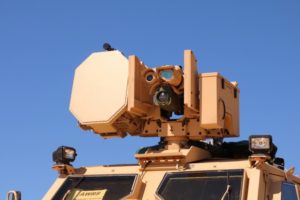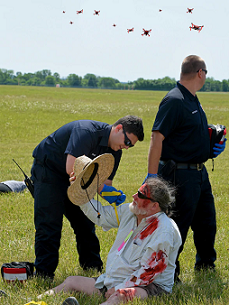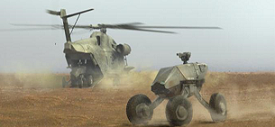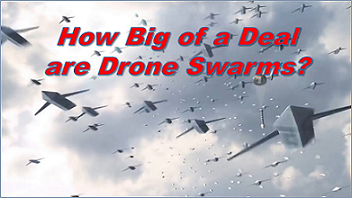[Editor’s Note: The U.S. Army’s capstone unclassified document on the Operational Environment (OE) states that by mid-century:
“Unmanned systems, including advanced battlefield robotic systems acting both autonomously and as part of a wider trend in man-machine teaming, will account for a significant percentage of a combatant force. Swarms of small, cheap, scalable, and disposable unmanned systems will be used both offensively and defensively, creating targeting dilemmas for sophisticated, expensive defensive systems.  Swarming systems on the future battlefield will include not only unmanned aerial systems (UAS) but also swarms across multiple domains with self-organizing, self-reconstituting, autonomous, ground, maritime (sub and surface), and subterranean unmanned systems.”– TRADOC Pamphlet (TP) 525-92, The Operational Environment and the Changing Character of Warfare, p. 17
Swarming systems on the future battlefield will include not only unmanned aerial systems (UAS) but also swarms across multiple domains with self-organizing, self-reconstituting, autonomous, ground, maritime (sub and surface), and subterranean unmanned systems.”– TRADOC Pamphlet (TP) 525-92, The Operational Environment and the Changing Character of Warfare, p. 17
Guest blogger Zachary Kallenborn returns with today’s post assessing the impact that these drone swarms will have on the Operational Environment, specifically addressing their military risk to great powers, risks to the American people, the military risks to small powers, and risks to human rights. This timely piece will whet your appetite for tomorrow’s Mad Scientist webinar on Future of Unmanned Ground Systems — information on how to register to participate in this event is located at the bottom of this post, along with links to previous posts and a podcast featuring two of tomorrow’s webinar presenters — Dr. Alexander Kott and Sam Bendett. For now, read on to learn how we can mitigate the risks associated with drone swarms and the renaissance of mass that they portend in the Operational Environment! (Note: Some of the embedded links in this post are best accessed using non-DoD networks.)]
A friend, Alessandro Regio, asked me the other day:
“So, on a scale from 1-10, how screwed are we on drone swarms? 10 being completely screwed, 1 being not at all.“
(The question is paraphrased for clarity and to remove an unpublishable expletive!)
 His question is a good one. As the technology matures, global proliferation is likely inevitable. The technology is new, but relatively uncomplicated. Success depends on getting multiple drones to talk and collaborate. That task is simple enough that the Strategic Capabilities Office’s leading drone swarm was first designed by MIT engineering students.1 Likewise, relatively small military powers like Turkey are doing leading research and reportedly plan to export their weapons.2
His question is a good one. As the technology matures, global proliferation is likely inevitable. The technology is new, but relatively uncomplicated. Success depends on getting multiple drones to talk and collaborate. That task is simple enough that the Strategic Capabilities Office’s leading drone swarm was first designed by MIT engineering students.1 Likewise, relatively small military powers like Turkey are doing leading research and reportedly plan to export their weapons.2
So how screwed are we? My intuition is about a “6.” However, it really depends on what is meant by “we.” The risk from drone swarms varies and can be examined from at least four separate perspectives: the military risk to great powers, risks to the American people, the military risks to small powers, and human rights risks. Let us consider each in turn.
Great powers — a “4”
 As drone swarm technology is new, great powers have time and opportunity to build better defenses, acquire and incorporate them, and develop international norms and treaties. A key question that will change the risk is: how successful are these risk-reduction measures in practice? Current – and quite limited – evidence points to existing counter-measures being inadequate. Even crude swarms may have successfully defeated Russian air defenses and modeling suggests small swarms would overcome the defenses of currently equipped destroyers.3 However, good reasons exist to hesitate in drawing conclusions about what this means for the United States and other great powers. A novel technology is likely to have early successes, because their targets are not prepared for them.
As drone swarm technology is new, great powers have time and opportunity to build better defenses, acquire and incorporate them, and develop international norms and treaties. A key question that will change the risk is: how successful are these risk-reduction measures in practice? Current – and quite limited – evidence points to existing counter-measures being inadequate. Even crude swarms may have successfully defeated Russian air defenses and modeling suggests small swarms would overcome the defenses of currently equipped destroyers.3 However, good reasons exist to hesitate in drawing conclusions about what this means for the United States and other great powers. A novel technology is likely to have early successes, because their targets are not prepared for them.

Subsequent training, doctrine, counter-measures, and other developments may mitigate that success entirely. After all, the Department of Defense just stood up a new counter-drone program.4 All that may take a few years – defense bureaucracies are inherently slow to innovate – but the long-term threat may end up being fairly minimal.5 Or the counter-measures may be ineffective and the swarm poses a great threat. The cheap mass of drone swarms may prove quite effective against exquisite, but expensive U.S. platforms.6 But either way, there is time (albeit rapidly diminishing) to figure it out before the swarm poses threats to major platforms.

American people — a “5”
Direct risks to the American homeland from drone swarms are middling. Drone swarms offer terrorists access to the air and reduced operational risk at relatively low cost. In some cases, the risk could be significant: swarms could damage airplane engines and wings, strike sensitive facilities, and wreak  havoc on soft targets.7 However, adversaries are relatively limited in their ability to acquire large and sophisticated swarms due to industrial, organizational, and infrastructure constraints.8 Although commercial software allows multi-drone control, operating large numbers of drones is difficult without high degrees of autonomy.9 Simple attacks, such as ISIS’s rampage attacks will likely be more impactful and cost effective in general.10 Likewise, years of counter-terrorism investment has helped make successful terrorist attacks on the homeland relatively rare. At least for now.
havoc on soft targets.7 However, adversaries are relatively limited in their ability to acquire large and sophisticated swarms due to industrial, organizational, and infrastructure constraints.8 Although commercial software allows multi-drone control, operating large numbers of drones is difficult without high degrees of autonomy.9 Simple attacks, such as ISIS’s rampage attacks will likely be more impactful and cost effective in general.10 Likewise, years of counter-terrorism investment has helped make successful terrorist attacks on the homeland relatively rare. At least for now.
Small powers — a “7”

Because drone swarm technology is relatively easy to acquire, smaller powers could quickly find themselves in bad positions if they fail to adopt the technology or adequate defenses are inaccessible. Smaller military powers are unlikely to be able to develop and field the degree of counter-measures that great powers have, so it matters who adopts the technology and who does not. If two adversaries both adopt or not adopt, neither may gain an advantage over the other. However, if one adopts but the other does not, the advantages could be significant.
Drones and drone swarms could even allow well-resourced non-state actors to achieve air superiority over a state. Drones and drone swarms provide non-state actors’ access to the air, and small state adversaries may have little to no air power of their own. Such air superiority is likely to be localized, only exist at low altitudes, and may not last long; however, it may enable meaningful close air support, reconnaissance, and strikes against soft targets. General McKenzie, the head of CENTCOM, already is warning the United States cannot keep up with drone attacks in the Middle East.11 Smaller military powers will have even more difficulty.
Human rights risks — a “10”
 Drone swarms, particularly with high degrees of autonomy, are a major threat to all those who care about protecting civilian lives. The combination of high damage potential and difficulty distinguishing between civilian and military targets plausibly make drone swarms a weapon of mass destruction.12 Current technology does not adequately allow autonomous weapons to distinguish between military and civilian targets. Even if the weapon can distinguish between a rifle and a rake, it must consider whether the target is sick, injured, or otherwise incapacitated. While experts disagree on how difficult that task is, both sides agree it will likely take decades.13 The challenge is magnified many-fold with drone swarms in which an error in one drone may propagate the mistake to a thousand others. While some states will no doubt refrain from adopting the technology, autonomous drone swarms offer significant advantage to nefarious regimes. Because ethnic distinctions are often superficial (and when they are not, are often perceived to be in racist propaganda), nefarious regimes may see great advantage in drone swarms as weapons of genocide. Imagine a Rwandan genocide carried out by a fleet of autonomous drones.
Drone swarms, particularly with high degrees of autonomy, are a major threat to all those who care about protecting civilian lives. The combination of high damage potential and difficulty distinguishing between civilian and military targets plausibly make drone swarms a weapon of mass destruction.12 Current technology does not adequately allow autonomous weapons to distinguish between military and civilian targets. Even if the weapon can distinguish between a rifle and a rake, it must consider whether the target is sick, injured, or otherwise incapacitated. While experts disagree on how difficult that task is, both sides agree it will likely take decades.13 The challenge is magnified many-fold with drone swarms in which an error in one drone may propagate the mistake to a thousand others. While some states will no doubt refrain from adopting the technology, autonomous drone swarms offer significant advantage to nefarious regimes. Because ethnic distinctions are often superficial (and when they are not, are often perceived to be in racist propaganda), nefarious regimes may see great advantage in drone swarms as weapons of genocide. Imagine a Rwandan genocide carried out by a fleet of autonomous drones.
What does this mean for the future operating environment?
The United States should expect to see drone swarm technology appear in numerous conflict areas around the world. That technology may be directed against the United States, alter the dynamics of other conflicts, and create major human rights concerns that may demand U.S. engagement. To the extent possible, the United States should search for synergies to address multiple risks at once. Options include:
-
-
- Investing in and expanding work in counter-swarm systems: Improving counter-swarm capabilities will be useful in reducing every threat. While the details of countering military swarms are likely to be different than terrorist use, the challenge is the same: the system must respond to multiple drones coming from different directions at once. Effective systems may be used to protect military assets, the homeland, and allied nations around the globe.
-
-
-
- Devolving counter-drone systems to the lowest organizational level possible: The potential low cost, broad proliferation of drone swarms mean low-level military units must be prepared to respond. The United States should consider providing counter-drone systems all the way down to the fire team level. Of course, such consideration should also consider the relative risk of drones versus other threats and the loss of any replaced capabilities.
-
-
-
- Developing international treaties and norms: Limits on the size of drone swarms and specific capabilities (e.g., self-targeting) reduce the risk from hostile swarm use. Even if adversaries nuzzle the edge of the treaty, limiting the size of the swarm creates advantage. If international treaties limit swarm size to 1,000 drones, the United States could worry less about 10,000 drone swarms (how much less depends on how effective verification and confidence measures are). Developing international treaties and norms can also address human rights concerns by creating broad recognition over drone swarm risks. Explicit export control treaties geared to drone swarms may help too.
-
 Drone swarms are worth worrying about, but how much worry depends on who is asking. Major military powers like the United States could develop counter-measures before swarms present a major risk, but the human rights concerns are difficult to counter. The United States should search for opportunities to reduce risk across every dimension.
Drone swarms are worth worrying about, but how much worry depends on who is asking. Major military powers like the United States could develop counter-measures before swarms present a major risk, but the human rights concerns are difficult to counter. The United States should search for opportunities to reduce risk across every dimension.
If you enjoyed this post, check out the following ones addressing the future of autonomous ground, air, sea, and space combat capabilities:
A New Age of Terror: The Future of CBRN Terrorism and A New Age of Terror: New Mass Casualty Terrorism Threats, by Zachary Kallenborn
Jomini’s Revenge: Mass Strikes Back!, by proclaimed Mad Scientist Zachery Tyson Brown
Ground Warfare in 2050: How It Might Look and “The Convergence” — Episode 6: The Intelligent Battlefield of the Future, featuring proclaimed Mad Scientist Dr. Alexander Kott
Major Trends in Russian Military Unmanned Systems Development for the Next Decade, Autonomous Robotic Systems in the Russian Ground Forces, and Russian Ground Battlefield Robots: A Candid Evaluation and Ways Forward, by proclaimed Mad Scientist Sam Bendett
The PLA: Close Combat in the Information Age and the “Blade of Victory”
Creating a Convergence of Technologies to Defeat the Deadly Fast Inshore Attack Craft Threat Before 2050, by CAPT George Galdorisi, (U.S. Navy–Ret.)
The Democratization of Dual Use Technology
Star Wars 2050, by proclaimed Mad Scientist Marie Murphy
>>> REMINDER: The Mad Scientist Initiative will facilitate our next webinar tomorrow, Tuesday, 18 August 2020 (1000-1100 EDT):
Future of Unmanned Ground Systems –  featuring proclaimed Mad Scientist Dr. Alexander Kott, Chief Scientist and Senior Research Scientist – Cyber Resiliency, ARL; Ms. Melanie Rovery, Editor, Unmanned Ground Systems at Janes; and proclaimed Mad Scientist Mr. Sam Bendett, Advisor, CNA.
featuring proclaimed Mad Scientist Dr. Alexander Kott, Chief Scientist and Senior Research Scientist – Cyber Resiliency, ARL; Ms. Melanie Rovery, Editor, Unmanned Ground Systems at Janes; and proclaimed Mad Scientist Mr. Sam Bendett, Advisor, CNA.
In order to participate in this virtual event, you must first register here [via a non-DoD network].
Zachary Kallenborn is a national / homeland security consultant with expertise in unmanned systems, weapons of mass destruction (WMD), and WMD terrorism. His work has been published in Studies in Conflict and Terrorism, the Nonproliferation Review, War on the Rocks, the Modern War Institute at West Point, DefenseOne, and various other outlets. His research has been written about in Forbes, Popular Mechanics, Homeland Security Today, the National Interest, and Yahoo News. His most recent study examines whether drone swarms could be considered weapons of mass destruction.
Disclaimer: All views expressed here are the author’s own and do not necessarily reflect those of the Department of Defense, Department of the Army, Army Futures Command (AFC), Training and Doctrine Command (TRADOC), or any current or former employers, funders, or affiliates.
1 Department of Defense, “Strategic Capabilities Office: Perdix Fact Sheet,” https://dod.defense.gov/Portals/1/Documents/pubs/Perdix%20Fact%20Sheet.pdf?ver=2017-01-09-101520-643
2 David Hambling, “Turkish Military to Receive 500 Swarming Kamikaze Drones,” Forbes, June 17, 2020, https://www.forbes.com/sites/davidhambling/2020/06/17/turkish-military-to-receive-500-swarming-kamikaze-drones/#174a8d81251a
3 Loc Pham, et al, “UAV Swarm Attack: Protection System Alternatives for Destroyers,” (Monterey, Calif.: Calhoun, The Naval Postgraduate School Institutional Archive, 2012), https://apps.dtic.mil/dtic/tr/fulltext/u2/a573999.pdf; Raf Sanchez, “Russia Uses Missiles and Cyber Warfare to Fight Off ‘Swarms of Drones’ Attacking Military Bases in Syria,” The Telegraph, Jan. 9, 2018, www.telegraph.co.uk/news/2018/01/09/russia-fought-swarm-drones-attacking-military-bases-syria
4 Yasmin Tadjdeh, “Just In: Defense Department to Stand Up New Counter-Drone Office,” National Defense, January 14, 2020, https://www.nationaldefensemagazine.org/articles/2020/1/14/just-in-defense-department-to-stand-up-counter-drone-office
5 Zachery Tyson Brown, “All This ‘Innovation’ Won’t Save the Pentagon,” DefenseOne, April 23, 2019, https://www.defenseone.com/ideas/2019/04/all-innovation-wont-save-pentagon/156487/
6 T.X. Hammes, “The Future of Warfare: Small, Many, Smart vs. Few & Exquisite?” War on the Rocks, July 16, 2014, https://warontherocks.com/2014/07/the-future-of-warfare-small-many-smart-vs-few-exquisite/
7 Zachary Kallenborn, “A New Age of Terror: New Mass Casualty Terrorism Threats,” Army Mad Scientist Laboratory, September 26, 2019, https://madsciblog.tradoc.army.mil/179-a-new-age-of-terror-new-mass-casualty-terrorism-threats/
8 Andrea Gilli and Mauro Gilli, “The Diffusion of Drone Warfare? Industrial, Organizational, and Infrastructure Constraints,” Security Studies, Vol 25, No. 1, February 25, 2016, https://www.tandfonline.com/doi/abs/10.1080/09636412.2016.1134189
9 Amy Hocraffer and Chang S. Nam, “A Meta-analysis of Human-System Interfaces in Unmanned Aerial Vehicle Swarm Management,” p. 66.
10 Benjamin Mueller, William K. Rashbaum, and Al Baker, “Terror Attack Kills 8 and Injures 11 in Manhattan,” The New York Times, October 31, 2017, https://www.nytimes.com/2017/10/31/nyregion/police-shooting-lower-manhattan.html
11 “MEI Engagement with General Kenneth F. McKenzie Jr.,” U.S. Central Command, June 11, 2020, https://www.centcom.mil/MEDIA/Transcripts/Article/2216473/mei-engagement-with-general-kenneth-f-mckenzie-jr/
12 Zachary Kallenborn, “Future Warfare Series No. 60: Are Drone Swarms Weapons of Mass Destruction?” United States Air Force Center for Strategic Deterrence Studies, May 6, 2020, https://media.defense.gov/2020/Jun/29/2002331131/-1/-1/0/60DRONESWARMS-MONOGRAPH.PDF
13 Ronald Arkin, Governing Lethal Behavior in Autonomous Robots, (Boca Raton, Fla.: Taylor and Francis Group Publishing, 2009), p. 45.




Like the layout/integration into the OE aspect. Yet the nagging part of all this is the blog reads like an acquisition approach rather than a full on DOTMLPF-P approach; specifically, the training issue.
Buying training sets, using training sets from operator through capstone events (e.g., NTC, 29 Palms, etc.), development of doctrine and TTPs to support training (including sustainment aspects of upgrading and maintaining training set to maintain parity with fielded systems), and simply finding places to do training (NTC = at NTC, home station =…..uhm).
Imagine trying to do a 100, 500, or 1000 UA swarm training event at Fort Riley, Fort Rucker (talk about congested airspace), or even Fort Ord and the FAA will be in “ground then” mode immediately due to safety of the national airspace system (and we just had a UAS incident reported with Air Force One, so….https://www.military.com/daily-news/2020/08/18/military-investigating-reports-of-drone-flying-near-air-force-one.html).
Then there is the counter-UAS, counter-swarm training issue. What, exactly, is the best approach besides a layered one of detection, jamming, laser/high powered microwaves (HPM)? And where can I jam in the US where it isn’t illegal because: FAA and NAS safety under Title 18 means no jamming of aircraft unless there is an express need to (training isn’t one of those). How do I train with high powered lasers and HPM as they are directed energy weapons and whatever is behind the target(s) is also at risk.
Add in having to send swarms up to conduct counter-swarm, counter-UAS training and that adds additional issues with the NAS not to mention exposing what does and doesn’t work to our adversaries and allies (saving them time along with being able to develop countermeasures before fill fielding and use).
Valid concerns, Pat, but not all training must be Live training. In instances where Risk Management precludes executing certain battlefield effects in a Live training environment due to safety, environmental, cost, or other concerns, Virtual or Constructive training can be integrated with the Live training event to replicate and simulate these effects. With the advent of the Synthetic Training Environment, more diverse battlefield effects will be able to be replicated and injected into training events.